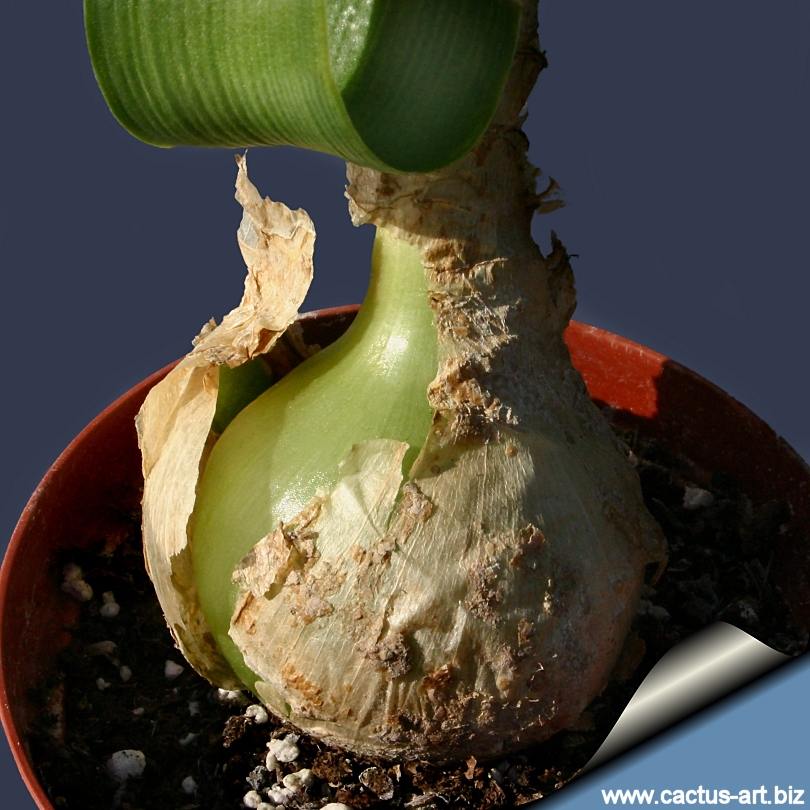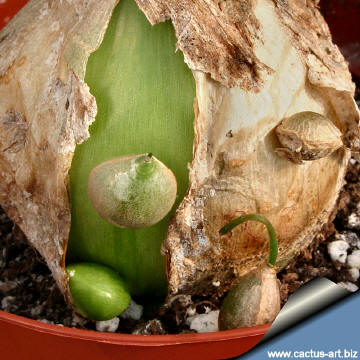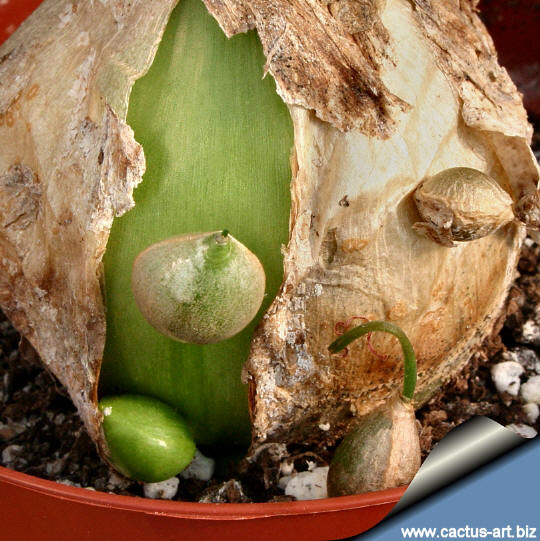|
|
|

Ornithogalum caudatum, False Sea Onionis
This is a rather curious bulbous plant
and unlike an true onion however, the bulb grows above ground, reaching up to
10 cm in diameter. Incidentally, the “onions” are decidedly NON-edible!
|
Description: Ornithogalum caudatum, or False Sea Onion, is a rather
curious bulbous plant and looks very similar to an onion. It a classic cryptophyte
(with bulb-like stem) that dies back during the dry period of the
Mediterranean climate.
Bulb: Large smooth, opalescent, pale apple-green, that sit on top of the
medium and will reach up to 10 cm in diameter. When larger produce
bulbils on their sides.
Leaves: Strap-like, semi-succulent and can grow very long under ideal
circumstances up to 40 (100)cm in length, The leaves droop.
Flowers: Form a 70-90 cm flowering spike capped small, white fragrant
flowers with green, central stripes. There may be as many as 50 to
100(-300) flowers per stalk.
Blooming Time: Usually flower from May to August.
|
 |
 |
|
|
|
 |
 |
|
Warning: Most parts of the plant are considered highly toxic. Dermatitis
is common in some people who handle the plants. The size and
attractiveness of the little bulblets may pose a choking danger to
children.
Advertising |
|
|
|
|
|
|
Family: Liliaceae (The
Lily family)
Scientific name:
Ornithogalum caudatum (Aiton) Maire
Origin: South Africa. Altitude
(min/max): 0/300 m
Common English Names include: False Sea Onion, Pregnant
Onion seeds Pregnant Onion, False Sea Onion
German Onion
Synonyms: Ornithogalum longibracteatum
Jacq.
|
|
|
|

|
|

The pregnant part is owed to its strange distinction of producing babies
on the bulb scales that are visible as small bumps on the surface. To
show off the ‘pregnancies,’ occasionally remove the papery outer layers
and drying leaves.
Cultivation:
It is an easy and adaptable plant to grow and it is well suited for containers
growing happily in a pot for many years. It makes a good but odd
houseplant or specimen. Prefers some direct sun but will scorch in hot, sunny, dry locations. In
the greenhouse, use a suffice cactus soil with some peat (a soil that
retains water yet drains well). The plants are allowed to dry slightly
in-between waterings. If the plants are allowed to dry too much, they
will go dormant. During the winter months, the plants are allowed to go
dormant and are stored in the cold storage until spring. Temperature:
Reportedly hardy down to -5°C.
Propagation: Division, seeds, offsets (bulbils). Produces somatic
embryos (bulbils) on the bulb scale tissue, visible as small bumps
(pregnancies) on the surface of overlying bulb scales in mature
specimens. These eventually fall off when outer scale layers
disintegrate or split. The bulblets then root and establish new
plantlets. Copious seed is also produced and germinate easily. It is
best to propagate seeds in the spring through summer in a mixture of
moist peat and perlite. Cover the pot and plant with a plastic bag
secured by a rubber band to prevent the moisture from escaping. Place in
indirect sunlight or under a fluorescent light. Repot in its regular mix
after it has been growing for a while. After dividing plant or removing
offsets, pot it in its regular potting mix.
Ethnobotanical/Economic Uses: In its native habitat, crushed leaves are
sometimes tied over cuts and bruises and said to have healing effects
similar to aloe vera. Also used as cooked syrup with rock candy against
colds.

 |
|







